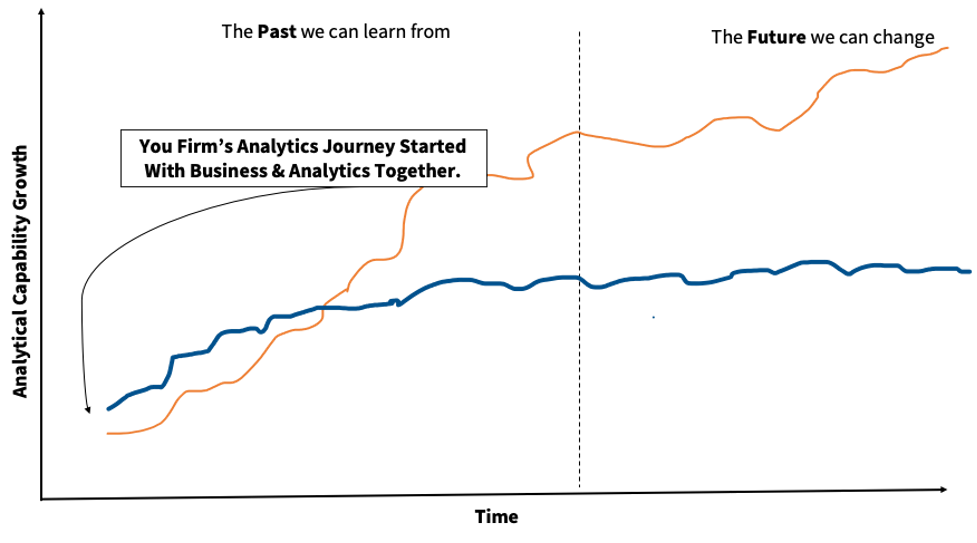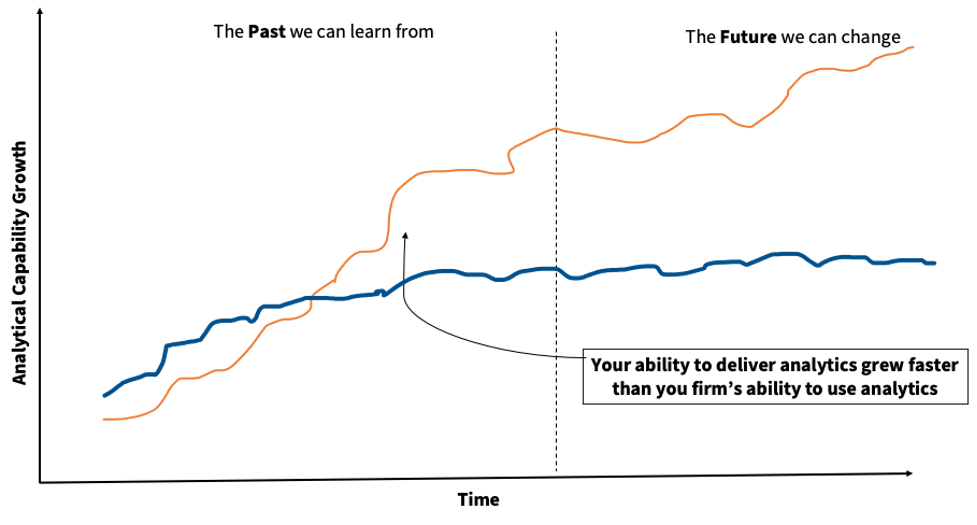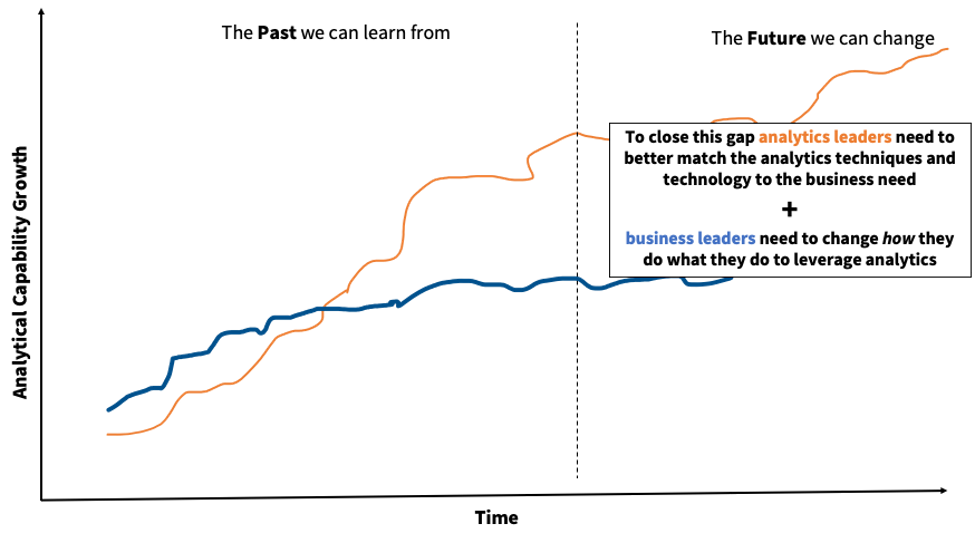
This is first in a series of blogs in which I will try to support closing a gap between the analytics that are possible and the business use of those analytics in reality. This yawning gap has been growing for a while and it’s not good. This first blog is intended to set the stage, to make the issue a bit clearer, so the guidance to close the gap makes a bit more sense.
It’s Hard to Solve a Problem You Can’t See

Many analytics functions have developed capabilities that are not being effectively deployed in the running business. In fact, analytics capabilities have grown so substantially that businesses, despite commitments to become data driven or data centric cannot keep up; and some even show signs of giving up trying. It’s not the that analytics aren’t impressive, they are impressive, in theory. The business has shown immense desire to do better business with analytics, but so far that desire has not led to sustained or substantial change. So, there is big gap between the potential of analytics and the everyday reality of what analytics delivers. This gap is increasing.
Analytics leaders are to blame. So are business leaders. Analytics advisors*, consultants, vendors and thought leaders, are also, definitely, to blame.
The gap is smaller in some firms and began to develop sooner in others. And the dotted line that represents “now” depends on where you are now. Still the general pattern is generalizable. Please keep in mind that the fact that the orange line has grown above the blue does not mean that analytics is better than business (as function, a group, etc.). It means we analytics professionals have increased the art of what’s possible at a much faster rate than science of what’s actionable.
*Not the author nor IIA, we are totally blameless.
We Didn’t Start Out Where We Are

Most firms did not start with a gap. In fact, you firm’s analytics journey started with business and analytics, dreaming big, together. As all business change starts with people, so did this one. Some of the people who started this off include
Math geeks with intrinsic belief in Big Data, conceptually, with as much emphasis on the big as the data
Studious types who devoured “Competing on Analytics” with bonus points to those who started right after the HBR article and didn’t wait for the book
Early Paul Reveres who spread the fear of Amazonification, which of course started with booksellers, but fear, after all is highly contagious
Discoverers of the inspiring stories of early adopters, like VISA, Starbucks, Tesco, Zara and many others who really showed what was (theoretically) possible
Alert C-suite types, often connected to MBB (McKinsey, BCG and Bain), who were among the first to see the opportunity, for businesses and for their business
An adventurous functional leader, usually someone in Marketing who knew that there must be a better way
In firms around the world these people found kindred spirits and set the sky as the limit. With data, by their side there was nothing analytics and business leaders couldn’t do!
You Got Busy Building Analytics

The list of things you likely did to build the capability the business needed is way too long, but for sure you at least did some of the following and much, much more.
Hired some Data Scientists, maybe even before HBR tagged the title “sexiest” job, because why should People be the only magazine to judge sexy
Lost some Data Scientists and hired some Data Engineers when your exit interviews revealed that Data Scientists don’t want to be Data Engineers
Took over analytics from functions with an angel on one shoulder (“it’s the right thing for the business given the constrained resources”) and devil on the other (“more analytics equals more influence”)
Drove value adding use cases, including Machine Learning and rejoiced when the ROI made eyes pop
Began a self-service journey or encouraged someone else to do so in order to increase the share of advanced analytics coming from your team
Began de-coupling from BI, see point above
Began a cloud migration or at least began to talk about a cloud migration, sometimes those two are indistinguishable
Began to get more demands from business leaders – more AI, more self-serve, more data, and thought “YES! This is exactly what we wanted to have happen. Wasn’t it?”
The Analytics Team Started to Gel and Get Smarter and Smarter

Your team’s understanding of each other and where the heck all that data sits grew really quickly, and you built some core foundational analytics that enabled you to build a lot of analytics even more quickly.
Teaming up Data Engineers, Data Scientists and Data Analysts created a virtuous circle of volume, with each analytics use case they got faster, and the faster they got the more analytics models they stockpiled
Always wishing to push the frontiers these teams looked outside for inspiration and terms like GPT-2 and BERT became common place (and no, it’s not a video game and Ernie’s roommate)
Cloud computing became something you could wrap your head around and the value of it a lot less opaque, to a few
Social media became minable, language became naturally processable and it seemed that the analytics potential was even greater than you had imagined
Whispers of this thing called Data Governance increased as the teams continued to have trouble accessing and trusting data
Although they couldn’t express it, the business began to feel like you had forgotten them, not realizing that your work on all of the points above - more models, new data types, deep learning techniques, and reliable data all in the cloud – all this work would make their work easier and more impactful. But when? And how?
It Takes Two to Tango and Many More to Get Value from Analytics

It’s over simplistic to divide the world into analytics and business, and I reserve the right to make it more complicated later. Still, for now I am going to stick with simple. And I am sure some of you have thought, “there is no analytics and business, analytics is an integral part of the business.” For some businesses this is a true statement of the everyday reality, but for most it’s an aspiration and simply repeating that mantra won’t make it so. Hard work and doing things differently will make it so. In the coming blogs I will cover areas where both the business should change to meet the analytics capability on offer and where analytics leaders should change to meet the business need.
About Drew
Drew has close to 20 years of experience, having worked on both the business side of analytics, leveraging insights for business performance, and on the delivery side of analytics driving the use of enterprise analytics. As the lead of Analytics Leadership Consortium, Drew drives engagement with analytics executives and top analytics practitioners in the IIA Community to help them lead their firm’s journey to analytics excellence.
Before joining the IIA, he led the Enterprise Data Analytics and Governance function at IKEA’s global headquarters in Europe. He leveraged analytics in various leadership roles across the IKEA value chain in both the United States and Europe. He received his MBA from Penn State and his undergraduate degree from Boston University.
About The Analytics Leadership Consortium (ALC)
The Analytics Leadership Consortium (ALC) is a closed network of analytics executives from diverse industries who meet to share and discuss real world best practices, as well as discover and develop analytics innovation, all for the purpose of improving the analytics maturity of their firms and securing the business impact they deliver.
You can view more posts by Drew here.
Follow IIA on LinkedIn, Twitter and Facebook for more updates.